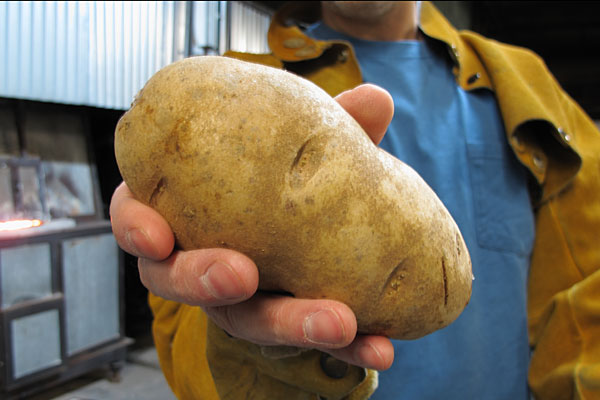Dipping a potato in a hot glass furnace may seem like an odd thing to do. This is actually an old glass factory trick.
This little known trick helps with melting clean, bubble-free glass… And there is some actual science to back this up.
Melting a pot of glass
We fill the glass furnace with the raw materials for glass, known as ‘Batch’. Here is a link for more information and a video about what is in our glass.
The cycle for melting glass is known as charging… And putting batch into the furnace is known as – “throwing in a charge”.
It generally takes all day to fill the furnace, throwing in more batch as the previous charge begins to melt.
We melt the glass at a very hot temperature of 2400º degrees Fahrenheit, or 1315º Celsius.
The raw materials begin to melt together. Small gassy bubbles, known as ‘seeds’, form in the glass during the melting cycle.
These tiny bubbles or ‘seeds’ will rise to the top of the glass, dissipating away. Getting the seeds to rise to the surface is helped along when the furnace temperature is lowered to 2000º degrees Fahrenheit, or 1093º Celsius. This process is known as the ‘squeeze’.
However, sometimes these seedy bubbles can’t make it to the surface before the glass reaches the lower glass blowing temperature. The glass is no longer viscous enough and the bubbles become trapped in the glass.
Potato in glass
Seedy bubbles is one of the reasons dipping a potato into the hot glass during the melting cycle is helpful.
The potato has a lot of moisture. This moisture very quickly turns into steam. This volatile burst of steam helps mix the molten glass components.
The steam also creates very large bubbles. Large bubbles have a much easier time reaching the surface during the ‘squeeze’. As these larger bubbles rise, they incorporate the tiny seed bubbles.
This gives us a better chance for clean bubble-free glass to make our glass sculptures.
I have heard of people using other things, such as apples, for this process… But a potato in glass is my choice of fruit or vegetable.
By Bernard Katz

